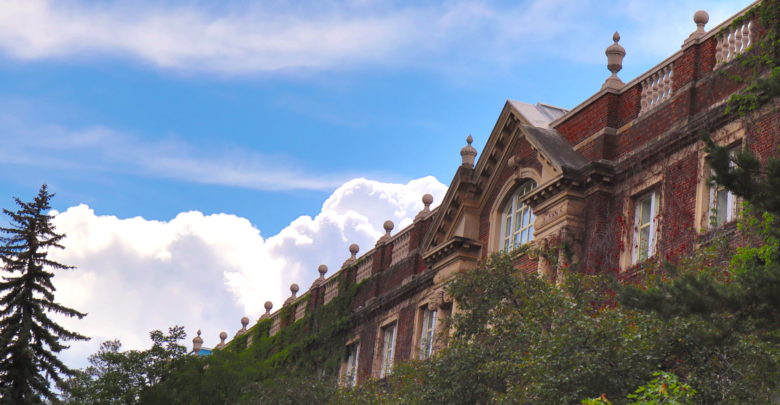 Lily Polenchuk
Lily PolenchukUnveiled on September 19, the University of Alberta released its 10-year strategic plan, SHAPE. Though the university seems to be content with its goals, the plan features grandiose ideas, causing more concern than excitement amongst students and faculty.
Some of SHAPE’s main goals include boosting university rankings and increasing enrolment by 16,000 students over the next 10 years. SHAPE emphasizes the idea of proceeding into the future purposefully — purposeful education, purposeful research, and purposeful engagement.
However, how purposeful can this plan really be? It doesn’t seem to listen to the concerns of current U of A community members. Issues like quality of education, mental health supports, and job security are not being addressed.
Students and faculty have needs that need to be taken care of urgently. Instead, the U of A presented us with a plan that focuses on improving university rankings and growing the student body, with little explanation as to how they’ll accomplish this. It seems to me that they think they can improve our university without addressing the U of A community’s concerns.
Internal issues at the U of A are nothing new. Problems such as quality of education, difficulty accessing mental health supports, and access to resources were already issues the U of A faced before. Now, they’re only amplified by the COVID-19 pandemic, academic restructuring, and budget cuts.
Students questioned issues relating to standards of education during the pandemic. Many students struggled with online learning, and the university failed to deliver quality education. Post-pandemic, many of these problems are still around. The U of A needs to focus on raising the standard of education again. Yet, the plan does not seem to adequately address this concern. Students pay thousands of dollars for their degrees. It is only fair that at that price point, students are receiving top-notch education. This doesn’t seem to be the case over the past few years.
In fact, tuition is only rising. The university increased tuition again last year with the promise of ensuring program quality.
In order to meet the 35 per cent enrolment increase, the university hopes to accept more international students. In the last round of tuition increases, tuition for incoming international students increased by 6.5 per cent. As well, they don’t have the benefit of a 2 per cent tuition cap like domestic students. International students will be doing the heavy lifting to deliver SHAPE’s goals, but their increasing concerns haven’t been addressed.
This further exasperates concerns about the quality of education, especially for the amount students are paying. SHAPE has given the university an opportunity to remedy this issue, yet they chose to focus on outward growth instead.
Academics aren’t the only area in which the university is not meeting students’ needs. Support systems such as mental health supports offered on campus or through the university are often inadequate. Students find themselves struggling with their mental health, but campus offers limited support options. If the current system can’t keep up with the student body now, how will it handle 16,000 more students? Students deserve actual support and concrete action from the institution that is supposed to be looking out for us, not big ideas that will only hurt us more.
Students aren’t the only ones falling victim to the university’s shortcomings — U of A academic staff face job insecurity and precarity. Some instructors only find out on short notice whether or not they’ll be teaching a course that semester. This leaves little time to prepare, causing education quality to suffer in a vicious cycle.
Many instructors work under temporary, short-term contracts, forcing them to go through rehiring when the semester is over. Short-term contracts with no benefits should not be the norm for U of A instructors. It’s a precarious working situation that causes unnecessary stress for instructors who deserve to have a stable, predictable job. It’s ironic that the institution providing degrees to increase chances of job security is the reason behind job insecurity for so many.
The lack of forethought doesn’t end there. The U of A won’t just struggle to support 16,000 more students — it isn’t equipped to physically handle them, either. What’s worse, the university has done nothing to mitigate that.
In fact, in 2022, the university announced its intention to remove the Humanities Centre, without plans for replacement. Simply put, where will we find the space for an additional 16,000 students? The university has suggested moving students into other spaces on campus. But the community raised concerns that this would reduce the quality of space students are learning in. New infrastructure is essential to support the influx of new students. However, the university wants to shut down buildings that are a necessity to current ones.
Where is the plan to provide support for students? Where is the plan to provide job security for instructors? Where is the plan to provide the necessary infrastructure to accommodate a larger student body? Despite all these concerns, answers are nowhere to be found in SHAPE. Instead, shiny new ideas are brought in without much indication of how the university is going to address pre-existing issues. SHAPE mentions aiming to provide quality education, but doesn’t elaborate on how.
On top of these shortcomings SHAPE has, it seems alarmingly optimistic in regards to funding. In order to support the proposed 35 per cent enrolment increase, the U of A needs more money. In the strategic plan, it even acknowledges that the attainability of these goals is contingent on provincial government funding. Yet recent years have seen unacceptable and unprecedented funding cuts, directly causing an increase in tuition for students.
With the unpredictability of the United Conservative Party (UCP) government that has continually cut the U of A’s budget, more contingency is necessary. Funding cuts forced the U of A to cut 400 faculty positions in 2020, raise tuition in 2022, and have harmed program quality. The 33 per cent funding cuts the university saw in 2020 led to academic restructuring at the university. Thus, the cycle continues.
If the university is struggling to hold on to current funding, how can they expect to gain even more in order to carry out the strategic plan? If they do manage to secure additional funding, how is it fair to current students to use this funding for new goals rather than fixing old issues?
The most confusing part of the strategic plan is understanding why the U of A feels the need to boost enrolment. If the goal is to be a top-performing university both in Canada and globally, wouldn’t it make more sense to put resources into quality and not quantity? If the U of A really wants a higher ranking, wouldn’t it serve them better to fix all these internal issues first?
The U of A’s strategic plan just isn’t adequate for its current members — students and faculty shouldn’t settle. Students shouldn’t be worrying about whether they’ll be paying more in tuition, while receiving less in education. Faculty should not be worrying about whether they’ll have a job next semester.
If the U of A really wants to be a top-tier university, it needs to focus on remedying internal issues first before looking to expand outward. The goals in SHAPE just don’t represent what the U of A really needs in order to thrive. Pretty words and fancy rebrands aren’t enough – the U of A needs action.




